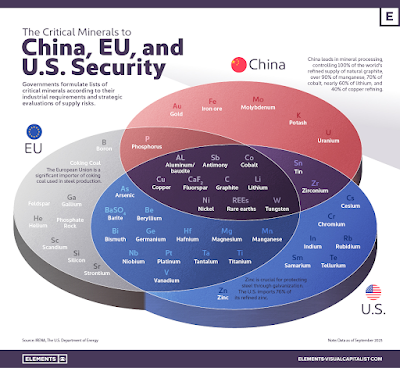Latin America: Mining and Energy Macro Trends
Latin America plays a preeminent role in the supply chains of raw materials useful for the energy transition, and even contributes to global sustainability by saving in case the climate helps lower hydrocarbon prices due to its heavy use of hydroelectricity.
This region has two geologically driven development
tracks: 1) the Atlantic front specializing in hydrocarbons and 2) the Pacific
front specializing in copper and lithium.
There are other minerals and rare earths. The
differentiations are not exclusive, but they influence the markets. The help of
the massive use of hydroelectricity and its little industrialization actually
help to free these raw materials for export, if the climate helps.
Future Trends
China is beginning to take advantage of space to
develop its electric vehicle industry in the Southern Cone and from there
connect to Mexico, which serves North America, Central America and the
Caribbean. Brazil and the lithium triangle will be key to China's development
of this industry.
The region also has the greatest hydrocarbon potential
when the slowdown in hydrocarbon investment will play an important role in high
oil prices in 3 or 4 years. In terms of energy security, the fact that large
hydrocarbon reserves are close to North America and that there are no hostile
straits or navies obstructing the flow to Europe allows the region to position
itself as a key supplier in the event of a generalized war in the Middle East
or a deterioration in relations between NATO and the Eurasian powers.
Obstacles and Threats
For Western powers, the Russian, Chinese, and Iranian
presence in the region may pose a threat, especially in terms of access to
hydrocarbons in the early stages of the energy transition. Hydrocarbons will
still be needed in 20 years or so as the energy transition takes shape, so the
influence of Eurasian powers on governments with large reserves, such as
Venezuela, is important. There is no better deal for the West than to overthrow
Maduro and install a free-market democracy that will make these resources available
to NATO, thus balancing crude oil prices while the energy transition takes
place.
These Eurasian powers with their political allies of
the Puebla Group in each country and regimes such as Cuba, Venezuela and
Nicaragua can affect the supply chains of strategic minerals in the Pacific Rim
through sabotage within their armed forces, promotion of organized crime or
irregular groups. It would be enough to affect the roads to the ports, thus
limiting exports from these countries. Petro practiced this method two years
before he became president, with the help of anti-Western powers and Colombian
irregulars. Nothing is easier than to blockade the countries of the Pacific
Rim: Colombia, Ecuador, Peru and Chile.
What to expect?
The West looks down on Latin America. The Eurasian
powers, i.e. Russia, China, India, Iran and the petro-Arab states, are much
more cautious and know the value of the region. If the West does not want to be
surrounded, it must become more involved in Latin America (EU-Mercosur
agreements or more aggressive initiatives from Washington could be a key
measure to counter the Chinese advance, which is the most aggressive).
Otherwise, it will have its best source of food, minerals and hydrocarbons as a
threat that is difficult to manage.




Comments
Post a Comment